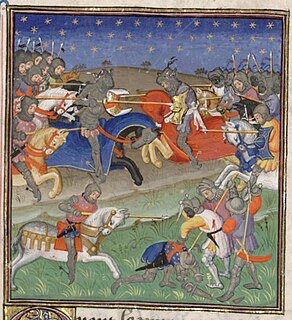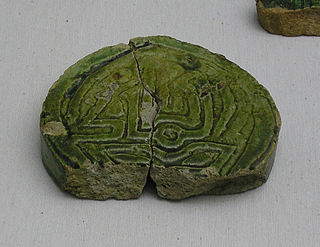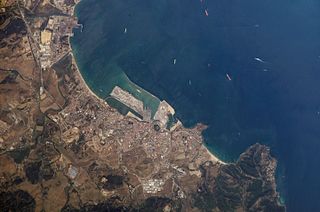
Alfonso XI, called the Avenger, was the king of Castile, León and Galicia. He was the son of Ferdinand IV of Castile and his wife Constance of Portugal. Upon his father's death in 1312, several disputes ensued over who would hold regency, which were resolved in 1313.

The Battle of Río Salado, also known as the Battle of Tarifa was a battle of the armies of King Afonso IV of Portugal and King Alfonso XI of Castile against those of Sultan Abu al-Hasan 'Ali of the Marinid dynasty and Yusuf I of Granada.

Abu Al-Hasan 'Ali ibn 'Othman, was a sultan of the Marinid dynasty who reigned in Morocco between 1331 and 1348. In 1333 he captured Gibraltar from the Castilians, although a later attempt to take Tarifa in 1339 ended in fiasco. In North Africa he extended his rule over Tlemcen and Ifriqiya, which together covered the north of what is now Algeria and Tunisia. Under him the Marinid realms in the Maghreb briefly covered an area that rivaled that of the preceding Almohad Caliphate. However, he was forced to retreat due to a revolt of the Arab tribes, was shipwrecked, and lost many of his supporters. His son Abu Inan Faris seized power in Fez. Abu Al-Hasan died in exile in the High Atlas mountains.
This is a timeline of notable events during the period of Muslim presence in Iberia, starting with the Umayyad conquest in the 8th century.

The Battle of Teba took place in August 1330, in the valley below the fortress of Teba, now a town in the province of Málaga in Andalusia, southern Spain. The encounter occurred during the frontier campaign waged between 1327 and 1333 by Alfonso XI of Castile against Muhammed IV, Sultan of Granada.

Abu al-Hajjaj Yusuf ibn Ismail, known by the regnal name al-Muayyad billah, was the seventh Nasrid ruler of the Emirate of Granada on the Iberian Peninsula. The third son of Ismail I, he was Sultan between 1333 and 1354, after his brother Muhammad IV was assassinated.
Abu Abdullah Muhammad ibn Ismail, known as Muhammad IV, was the ruler of the Emirate of Granada on the Iberian Peninsula from 1325 to 1333. He was the sixth sultan of the Nasrid dynasty, succeeding to the throne at ten years old when his father, Ismail I, was assassinated.
Abu Yusuf Yaqub ibn Abd al-Haqq was a Marinid ruler of Morocco. He was the fourth son of Marinid founder Abd al-Haqq, and succeeded his brother Abu Yahya in 1258. He died in 1286.

The Battle of Algeciras was a naval battle which occurred on July 25, 1278. The battle pitted the fleets of the Kingdom of Castile, commanded by the Admiral of Castile, Pedro Martínez de Fe, and the combined fleets of the Marinid dynasty and that of the Emirate of Granada, commanded by Abu Yaqub Yusuf an-Nasr. The battle was fought in the context of the Moorish naval expeditions to the Iberian Peninsula. The battle, which took place in the Strait of Gibraltar, resulted in a Muslim victory.

The Siege of Algeciras was the first of many sieges of the city by Christian forces in the lengthy period of the Spanish Reconquista. The siege, ordered by King Alfonso X of Castile also known as "el Sabio", was a fruitless military campaign initiated by the Kingdom of Castile with the objective of removing the Benimerins from Algeciras. The siege on Algeciras, then known to the Muslims as Al-Jazira Al-Khadra, was strategically important because Algeciras had been at the time the main fortress and landing place for African reinforcement troops in the Iberian Peninsula. Castile, which had a powerful armada of ships anchored in the Bay of Gibraltar to blockade such reinforcement, had a few days previously to the siege, seen that fleet obliterated by the Muslim admiral, Abu Yusuf Yaqub at the Naval Battle of Algeciras.
The Second Siege of Gibraltar was an abortive attempt in 1316 by the forces of the Azafid Ceuta and the Nasrid Emirate of Granada to recapture Gibraltar, which had fallen to the forces of Ferdinand IV of Castille in 1309. The siege was part of a wider war in which Castile invaded Granada with the pretext of helping its vassal Nasr, the former Sultan of Granada who had been overthrown by his nephew Ismail I in 1314. As a response against the invasion, forces led by Yahya ibn Abi Talib al-Azafi governor of Ceuta allied to Granada, besieged Gibraltar and managed to enter some of its suburbs. Prince Peter, the regent of the Castilian king Alfonso XI led a combined land and naval forces to relieve the town, prompting the besiegers to abandon the siege. The war between Granada and Castile would continue for several more years, punctuated with truces, although Castilian invasion threat ended in the 1319 Battle of the Vega of Granada, which resulted in the rout of the Castilian forces and the death of Peter and another regent John.

The history of Moorish Gibraltar began with the landing of the Muslims in Hispania and the fall of the Visigothic Kingdom of Toledo in 711 and ended with the fall of Gibraltar to Christian hands 751 years later, in 1462, with an interregnum during the early 14th century.
The Third Siege of Gibraltar was mounted between February–June 1333 by a Moorish army under the prince Abd al-Malik Abd al-Wahid of Morocco. The fortified town of Gibraltar had been held by Castile since 1309, when it had been seized from the Moorish Emirate of Granada. The attack on Gibraltar was ordered by the recently crowned Marinid ruler Abu al-Hasan Ali ibn Othman in response to an appeal by the Nasrid ruler Muhammed IV of Granada. The onset of the siege took the Castilians by surprise. The stocks of food in Gibraltar were heavily depleted at the time due to the thievery of the town's governor, Vasco Perez de Meira, who had looted the money that was meant to have been spent on food for the garrison and to pay for the upkeep of the castle and fortifications. After over four months of siege and bombardment by Moorish catapults, the garrison and townspeople were reduced to near-starvation and surrendered to Abd al-Malik.

The Fourth Siege of Gibraltar, fought from June until August 1333, pitted a Christian army under King Alfonso XI of Castile against a large Moorish army led by Muhammed IV of Granada and Abd al-Malik Abd al-Wahid of Fes. It followed on immediately from the Third Siege of Gibraltar, fought earlier in 1333. The siege began inauspiciously with a disastrous landing by Castilian forces on the west side of Gibraltar, before developing into a stalemate in which neither side had the strength to capture Gibraltar, nor to break out or lift the siege. Both sides faced acute shortages of food – the Gibraltar garrison was cut off from resupply, while the Castilians, deep within enemy territory, could only be resupplied via an unreliable sea route. After two months of inconclusive siege warfare, the Castilians and Moors reached a truce agreement that allowed both sides to make an honourable exit from the siege. Although the Moors managed to keep Gibraltar, the truce cost Muhammed IV his life when he was assassinated by disgruntled nobles the day after signing it.
Abu Malik Abd al-Wahid was a son of the Marinid sultan of Morocco, Abu al-Hasan Ali ibn Othman. Although he had lost an eye, Malik was a capable military commander and served as governor of Algeciras and the Marinids' principal general in Al Andalus. He captured Gibraltar from Castile in June 1333 and participated in his father's campaign against rebels in the Kingdom of Tlemcen the following year. He was killed by Castilian forces in 1339 after being ambushed on the way back from a raid against the Castilian-held town of Jerez de la Frontera.
The Sixth Siege of Gibraltar in 1411 was the only occasion on which control of Gibraltar was contested between two Islamic powers. After the failed Fifth Siege of Gibraltar in 1349–50, which ended with the death of King Alfonso XI of Castile from bubonic plague, the Kingdom of Castile was preoccupied with the Castilian Civil War and its aftermath. In 1369, Sultan Muhammed V of Granada took advantage of the Castilians' distractions and in the Siege of Algeciras (1369) he seized the city of Algeciras, on the west side of the Bay of Gibraltar, which Alfonso XI had captured in 1344. After razing it to the ground he made peace with Henry II, the winner of the civil war. The truce was renewed by Henry's successors John I and Henry III. At some point during the truces, control of Gibraltar was transferred from the Marinid dynasty of Morocco, which had held it since 1333, to the Granadans. It is not clear why this happened; it may have been as a condition of the Granadans assisting the Marinids against rebels in Morocco.

The Siege of Algeciras (1342–44) was undertaken during the Reconquest of Spain by the Castillian forces of Alfonso XI assisted by the fleets of the Kingdom of Aragon and the Republic of Genoa. The objective was to capture the Muslim city of Al-Jazeera Al-Khadra, called Algeciras by Christians. The city was the capital and the main port of the European territory of the Marinid Empire.

The Siege of Algeciras (1369) was undertaken during the period of the Reconquest of Spain by Muhammed V, Sultan of Granada to reclaim the city of Al-Hadra Al-Yazirat, called Algeciras by the Christians, in the Kingdom of Castile. The siege lasted just three days, and the sultan was victorious. The Muslims thus regained a major city which had been in Castilian hands since Alfonso XI of Castile took it from the Moroccans after the long 1342-1344 siege. Ten years after the capture of the city, in 1379 the sultan of Granada decided to completely destroy the city to prevent it falling into Christian hands. It was impossible to defend the place at a time when the Muslim kings of the Iberian Peninsula had lost much of military power they enjoyed in earlier centuries.

The Battle of Martos was a minor battle of the Spanish Reconquista fought between Martos and Torredonjimeno in Andalusia in 1275. The battle was fought between the troops of the Kingdom of Granada and those of the Kingdom of Castile. The battle resulted in the complete annihilation of the Castilian force. There is some confusion in the dates since different authors report different dates. Zurita, for example, reports that the events described here took place between May and August; the more modern authors, however, put them between September and October.













